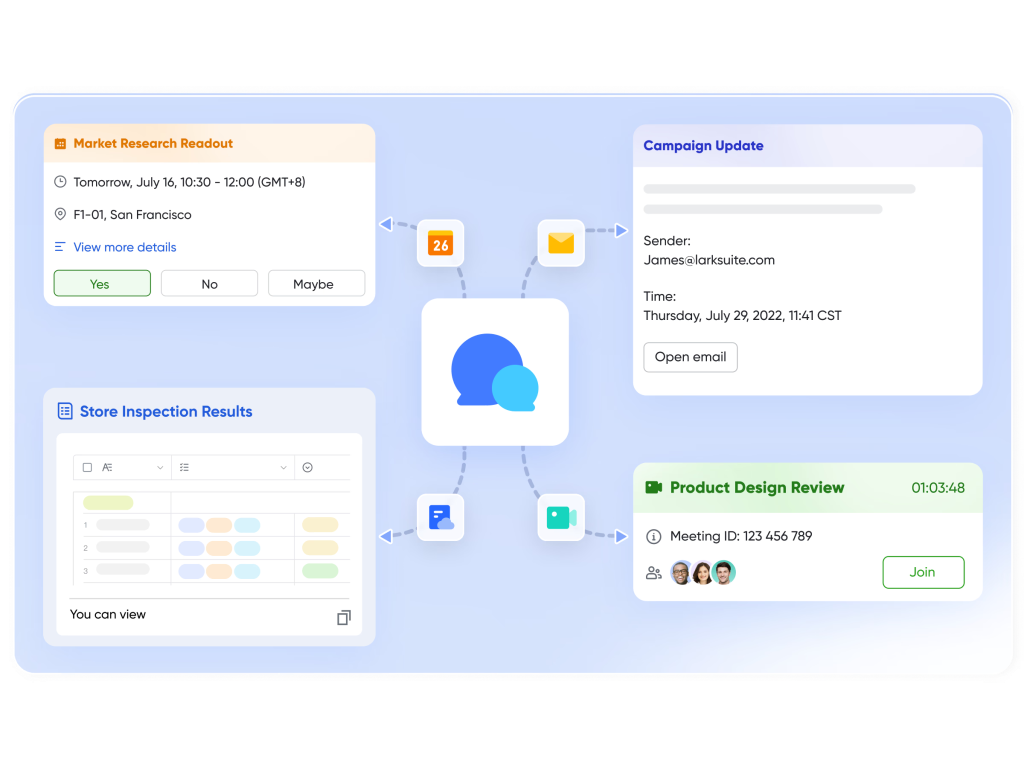A common situation for many teams in the modern workplace is a digital environment full of a dozen or more apps. One platform is for communication, another is for storing files, a third is for managing project tasks, and a fourth is for keeping meeting notes. Even while this broken-apart method comes from the finest intentions of using specialist tools, it often ends up in turmoil. Lark was built to solve this very problem. It’s not just a bunch of apps; it’s a real platform that puts all the tools you need to work together and get things done in one smart, unified workplace. Lark makes it possible to turn messy, disorganized workflows into clear, smooth processes by bringing together communication, project management, records, and automation.
Not only a set of tools, but a unified workspace
Among many project management tools what makes Lark stand out is the efficient performance in one place rather than a bunch of separate software programs. So, without further ado, let’s look at six important things that make this change from chaos to clarity possible with Lark’s six specialized features.
- The Lark Messenger dynamic hub
The Messenger is a daily communication hub of Lark. It’s not simply a chat app; it’s the platform’s brain. People don’t only text here; they also discuss tasks that need to be done. You may quickly turn a message into a task, make a calendar event, or establish a video call from inside a chat with just one click. This means you don’t have to jump between apps to do something related, which keeps the chat and the task linked. Lark Messenger also has features like polls in chat, rich text formatting, and thread replies to keep conversations structured and on topic. This makes sure that every message leads to a clear result.

- Lark Base makes it easy to stay organized
When you have a lot of data and tasks to keep track of, you usually need specific software. But Lark Base lets anyone create custom databases and apps without writing any code, ultimately enhancing the automated workflow process. You may change Lark Base to match your needs, whether you need a simple project tracker, a CRM, or a full inventory management system. You may see your data in the way that makes the most sense by using Kanban boards, Gantt charts, and spreadsheets. This feature lets people who aren’t tech-savvy make their own tools, turning a messy way of managing data into a clear and orderly one.
- Smart working together with Lark Docs
Lark Docs is much more than just a word processor. It is a powerful tool for working together in real time that lets many people edit a document simultaneously and view changes as they happen. What really makes it revolutionary is that it can include a lot of interactive components right into the document itself. You can add a poll to get comments, a task list to give people things to do, or even a video from a Lark Meeting. This makes a static page into a living project hub where tasks, ideas, and data are all linked and up to date. This gets rid of the confusion that comes with having different versions of a document and makes sure that everyone in the team is working from the same, dependable source of truth.
- Lark Wiki: A cloud knowledge base
For any business, information is a very important resource. Without a dedicated place to store information and best practices, they can get lost in discussions or obsolete documents. Lark Wiki is like a central brain for your business. It’s a place where you can make, organize, and share all of your knowledge. Teams can make structured knowledge bases that include things like project playbooks, onboarding guidelines, corporate policies, and frequently asked questions (FAQs). The Wiki’s easy-to-use layout and robust search feature make it simple for employees to quickly access the information they need. This cuts down on queries that are asked over and over again and gives employees greater freedom.
- Lark Calendar and video calls make meetings easy
Making plans and keeping track of calendars can cause a lot of problems. Lark Calendar makes this easier by showing when team members are available in real time, so it’s easy to choose a time that works for everyone. The video call link is automatically added when a meeting is set up. The Lark Magic Share feature lets people update a Lark Doc together right in the meeting window during the call. Lark Minutes is an AI-powered transcribing tool that automatically writes down what was said during the meeting, makes a summary, and lists the next steps. This single procedure includes the entire meeting lifecycle, from scheduling to following up after the meeting, so nothing is missed.
- Intelligent automation for more efficient workflows
The real magic of Lark is its automated workflow process. You may connect the many aspects of the Lark platform to make sophisticated, automated processes with Lark workflow automation. You can set up a rule in Lark Base that sends a message to the team in Lark Messenger whenever a new job is assigned. When someone asks for approval in a Lark Doc, Lark Approval starts a pre-set approval workflow. Lark takes care of these boring, repetitive activities for you, so your team can spend more time on strategic and creative work instead of becoming stuck in administrative busywork.
In conclusion
Moving from a chaotic, app-swapping workflow to a clear, consistent one is more than simply a question of convenience; it changes the way a team works. As business process management software, Lark gets rid of the problems that slow down productivity by putting communication, collaboration, and automation all in one place. It gives everyone on the team the same information, makes sure everyone is on the same page, and gives each person the power to work smarter. Lark offers a clear way for organizations to get out of the digital mess and into a new era of clarity and productivity. This is great for businesses that want to improve efficiency, simplify processes, and encourage a culture of smooth cooperation.






